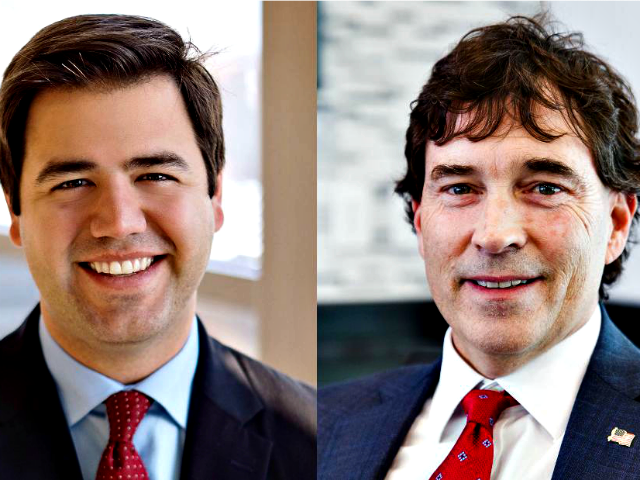Last week’s special election in Ohio’s 12th Congressional District–where Republican Troy Balderson clings to a 1,564 vote lead as provisional and absentee ballots remain to be counted–has been held out by some pundits as an indication Democrats have momentum in their effort to gain back a majority in the House of Representatives this November.
Democrats will need a net gain of 23 seats to take back the majority by a one vote margin.
Several reports attribute the narrowness of Balderson’s apparent, yet unconfirmed, victory in a district Donald Trump won by 11 points in 2016 to a much higher turnout rate in the district by Democrats over Republicans.
While control of the House of Representatives when the 116th Congress convenes in Washington, D.C. may well hinge on which party does a better job of turning out the vote, the Ohio-12 special election results provide little evidence of which party will actually do so.
The Cook Political Report gives Republicans a seven point partisan voter index advantage in Ohio-12. President Trump over performed by four points more than the GOP partisan voter index advantage. Balderson, the Republican candidate in the special election who currently holds a 0.8 point lead in the race, in contrast, under performed by 6.2 points less than the GOP partisan voter index advantage.
“Did more Democrats or new ‘resistance’ voters turn out or did fewer Republicans go to the polls?” David Winston, a former adviser to Newt Gingrich and other Republicans who currently heads up the Winston Group, asked at Roll Call about the Ohio-12 special election results.
“Did moderates or independents, who in previous elections had leaned toward the GOP, simply decide to back a centrist Democrat this time, or were people sending the GOP and/or Trump a message?” Winston queried.
A Breitbart News analysis of the election results, when combined with the cross tabs of the Emerson College e-poll conducted the week before the election, suggests that Republicans and Democrats turned out at about the same rates in the Ohio-12 special election, but that Democrats supported their candidate at a slightly higher level than Republicans supported theirs.
The narrowness of the race, however, appears to be due to the voting behavior of Independents, who favored the Democrat candidate, Danny O’Connor, over the Republican candidate, Balderson, by almost a two-to-one margin.
The Emerson College e-Poll, released the day before the election, showed the race to be a “dead heat.” The poll was conducted from Thursday August 2 to Saturday August 4. President Trump held a rally in the district to support Balderson’s candidacy Saturday evening, as the poll was finishing up.
The cross tabs from that poll — which virtually mirrored actual election day results (the poll had the Democrat, O’Connor, up by one point, while election day results put the Republican, Balderson, up by 0.8 points)–showed that the polling sample included 44 percent Republicans, 26 percent Democrats, and 30 percent Independents. That ratio of respondents in the Emerson College poll–69 percent more self-identified Republicans in the district than self-identified Democrats–was slightly higher than the ratio of Republican voters in the May primary to Democratic voters, where there were 53 percent more actual Republican votes cast (67,315) than Democrat votes cast (43,945).
Fifteen percent of Republicans supported the Democrat candidate in the poll, while 82 percent supported the candidate of their own party, and three percent were undecided.
In contrast, 91 percent of Democrats supported the candidate of their party in the poll, while only six percent of Democrats supported the Republican candidate, and three percent were undecided.
Independents supported O’Connor, the Democratic candidate, by a two-to-one margin, 56 percent to 28 percent, with 16 percent undecided.
If voters behaved on election day as the sample responded in the Emerson College Poll, Balderson’s apparent narrow victory on election day can be attributed to the positive impact of President Trump’s rally for Balderson on undecided voters.
Balderson currently has 101,772 votes, or 50.1 percent of the 203,109 votes that were counted on election day. O’Connor has 100,208 votes, or 49.3 percent, and a third party candidate has 1,129 votes, or 0.6 percent.
One plausible explanation for these results is that voters behaved as the crosstabs in the Emerson College Poll completed the previous week suggested, and that assuming all three percent of undecided Republicans voted for Balderson, all three percent of undecided Democrats voted for O’Connor, and that the 16 percent of Independents who were undecided ended up voting for the Republican, Balderson, by a two-to-one margin. (Overall, Independents still voted for O’Connor by almost a two-to one margin.)
Much of the post-election analysis has focused on raw voter turnout.
One post-election report points out the Democrat candidate’s vote total in the special election was 87 percent of the Democrat candidate’s vote total in the 2016 general election, and that the Republican candidate’s vote total in the special election was 40 percent of the vote total of the Republican candidate’s vote total in the 2016 general election.
This data, however, is entirely unrelated to actual turnout rates by party affiliation in the August 7 special election in Ohio’s 12th Congressional District.

COMMENTS
Please let us know if you're having issues with commenting.